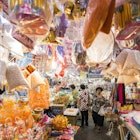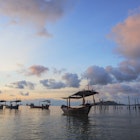
Toyosu is the new Tsukiji: exploring Tokyo's morning market

Feb 12, 2019 • 6 min read

Huge frozen tuna are sold at Toyosu market – the early-morning auction can be viewed by visitors © Kazuhiro Nogi / AFTP / Getty Images
After more than 80 years at Tsukiji, Tokyo’s wholesale market – famous for its tuna auction, exotic fish and breakfast sushi – moved to a new, purpose-built location in Toyosu in 2018. It’s not a perfect stand-in for the iconic former site, but it has its upsides, including shorter queues and bookable slots for the auction. Here’s what to expect and how to get the most out of your visit.

Seeing the Tuna Auction
As long as anyone can remember, the big attraction at the wholesale market has been the early-morning tuna auction. This is when the naka-oroshi (intermediate wholesalers) bid on fabulously expensive bluefin tuna, amid a frenzy of shouts, hand gestures and bells. It’s a fantastic gamble: the most prized fish have the highest fat content, but while the naka-oroshi can examine a cross section of the tail, the fish aren’t otherwise cut until after they’re sold, giving them little to go on to make their bets.

All of this is visible from a sealed, glass-walled corridor above the market floor. At Tsukiji, 120 visitors per day were allowed on to the market floor to witness the auction. At Toyosu nobody is allowed on the floor, but 120 people are allowed onto a platform, which is only partially sealed – from here you can get a closer look and hear the hubbub of the auction. (But you’ll still be taking pictures through glass.) There’s no need to queue up hours in advance to secure a spot, as was the case at Tsukiji – application is by lottery. From 5.30am, groups of 30 will be given 10 minutes each to get up close to the glass, so there’s no need to even worry about being first to arrive.
The tuna auction is held in the Fish Wholesale Market in block 7; follow signs for the Fish Wholesale Market Observation Gallery. From 5am, when the market opens to visitors, you can see the naka-oroshi inspecting the tuna (they start around 4am). The auctions get going around 5am and finish by 6am or 6.30am; afterwards there’s nothing to see, so come early.
Note that Japan is the world’s largest consumer of bluefin tuna, a prestige fish most famously eaten as sushi. Its popularity has led to dwindling numbers; the World Wildlife Foundation currently lists Atlantic, Pacific and Southern bluefin tuna as endangered. International commissions have set fishing caps to help bring numbers up to sustainable levels, but illegal fishing continues. Most of the tuna sold at Toyosu – which comes from all over the world – is wild-caught and flash-frozen, though you’ll increasingly see fresh fish as well, some it farm-raised.

Fruit & Vegetable Market
Visitors can also check out the Fruit & Vegetable Market, in block 6. The wholesale and the intermediate wholesale markets are in the same building, visible from above via a similarly sealed glass corridor on the second floor. Walk all the way down to the end to see the wholesale market, where somewhat less intense auctions for fruit and vegetables take place from 6.30am (lasting about an hour). There’s no special access here.

Fish Intermediate Wholesale Market
This collection of several hundred stalls in block 5 is where the naka-oroshi take their hard-won goods to sell to chefs and fishmongers. It was a highlight at Tsukiji, where all manner of sea creatures where displayed on ice for the eyes of professional shoppers, but in Toyosu visitors can only get us far as the observation gallery, where visibility is limited. Chock this one up as loss for travellers, but a win for market workers, who grumbled about tourists getting in the way. This part of the market sees action until around 10am.

Eating at the market
The tradition of following a tour of the market with sushi breakfast is still very much possible at Toyosu. Several of Tsukiji’s restaurants, which first opened to feed market workers but became gourmet destinations for Tokyoites and travellers alike, made the move to Toyosu. Among them are Sushi Dai, our top choice, and Daiwa Sushi. Both, and especially Sushi Dai, were famous for drawing long lines, but so far the waits are not as bad at the new market.
Like everything at Toyosu, the restaurants have that new feel, and are comparatively spacious and well-lit. The atmosphere is more like ‘mall food court’ than local market, but the food is still top class, with ingredients picked up directly from the stalls here. There are also shops that sell things other than sushi, like Mosuke Dango, a traditional sweets shop that’s now survived two market moves – it dates to the pre-Tsukiji market in Nihombashi.

Navigating the Market
The blocks are connected by outdoor promenades, which are also connected to the nearest train station, Shijō-mae (on the Yurikamome line). Everything is signposted in English, so getting around is pretty easy. The market is rather spread out, so if you plan to see a lot expect to travel a fair distance; however, it’s level and largely accessible. Visitors who require it can use an elevator to get to the lower level tuna auction viewing platform.
There are two main clusters of restaurants: one in block 7, at the entrance to the Fish Wholesale Market, and one in block 5, at the entrance to the Fish Intermediate Wholesale Market. The latter, where Sushi Dai is located, is where you’re most likely to rub shoulders with sushi chefs and other professional buyers (look for the telltale rubber boots and wicker shopping baskets).
On the 4th floor of block 5 there are some shops open to the public selling dry goods, like katsuo-bushi (dried bonito flakes, used in making broth) and tea, and kitchen supplies.
Top tips
Toyosu Market is on Toyosu, an artificial island on Tokyo Bay, near Odaiba. It is closed on Sundays and some Wednesdays, plus sometimes on other days; check the schedule before heading out. Information on the tuna auction lottery is posted there, too.
The market is open 5am to 5pm, but we recommend getting there early in the morning to see it when it is really in use. Most restaurants are open from 5am until around 1pm, on days when the market itself is open. Go to the tuna auction first (if you have a slot), before taking a peek at the Fish Intermediate Wholesale Market and then having breakfast at one of the market's food courts.
Getting to the market in time for the tuna auction by public transport is tricky. The first Yurikamome line train from Toyosu (two stops from the market) departs at 5.15am, but you have to get to Toyosu first. Accommodation here is limited; it still makes sense to stay around Ginza and take a taxi from there to the market (¥1500 to ¥2000, about 15 minutes).
Don’t take the Yurikamome line from Shimbashi; it looks convenient but follows a winding course that takes almost 30 minutes.
The market floor is kept at a precise and chilly 10.5°C, so dress warmly for the tuna auction.
https://shop.lonelyplanet.com/products/tokyo-city-guide-11
Explore related stories







